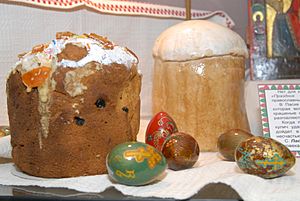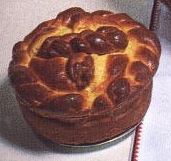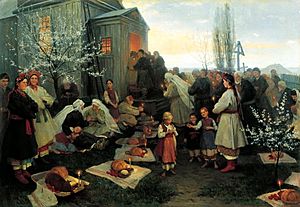Paska (bread) facts for kids

Traditional Ukrainian paska bread with a pysanka and willow switches
|
|
| Type | Sweet bread |
|---|---|
| Place of origin | European / Eurasian countries with predominant Orthodox religion |
| Main ingredients | Milk, butter, eggs, sugar |
Paska is a special sweet bread. It is a big part of Easter celebrations in Ukraine and many other countries. These countries often have strong cultural ties to the ancient Byzantine Empire and the Eastern Orthodox Church.
Paska bread is a traditional food during Easter holidays. You can find it in Ukraine, Armenia, Belarus, Romania, Russia, Georgia, and Moldova. It is also eaten in parts of Bulgaria, Turkey, and Iran. Because it is close by, it is also popular in Slovakia. People from Eastern Europe who live in places like the United States, Canada, and the United Kingdom also enjoy Paska.
Contents
What's in a Name?
The word "Paska" comes from an old word meaning "Easter." In Ukrainian, the word for Easter Day is Velykden'. The word Paska is used for the Easter bread itself. In Russia, their Easter bread is called Kulich, and the word Paskha means Easter Day.
The name "Paska" is linked to an old Greek word. It also connects to the Jewish holiday of Pesach, which is also called Passover.
It's interesting to know that in Finland, they call their Easter bread Pääsiäisleipä. This is because the word "paska" sounds like a rude word in Finnish!
Christian Meanings of Paska
Many Christians in Eastern countries eat this special bread during Easter. Paska breads have features that are connected to Christian beliefs. For example, the inside of Paska can be a mix of yellow and white. The yellow is said to represent the resurrection of Jesus. The white part stands for the Holy Spirit.
Some Paska breads have chocolate or rice inside. Others might have savory fillings made with cheese. A special version is made with bright red maraschino cherries. These cherries are added to look like royal jewels. They honor the resurrection of Jesus.
What Paska is Made Of
Paska is usually made with common baking ingredients. These include milk, butter, eggs, flour, and sugar.
However, the Romanian version of Paska, called Pască, is a bit different. It often includes sweet cream, cottage cheese, or sour cream. It also has eggs, sugar, raisins, and sometimes rum. Bakers often use a mix of egg and water to make the top shiny.
Paska Traditions in Ukraine
In Ukraine, it is a tradition to fill an Easter basket (called koshyk) on Holy Saturday. This is the day before Easter. The basket holds many special foods. These include Easter eggs (pysanky), Paska bread, sausage (kovbasa), butter, and salt.
On Easter morning, after church services, families go home. They then enjoy a feast with the foods that were blessed at church. People share Easter greetings and give each other colored eggs (krashanky).
In eastern Ukraine, families put the blessed food (sviachene) on the table. The oldest family member opens the cloth wrapping. They cut pieces from each food and share them with everyone. This includes a piece of blessed Paska.
In western Ukraine, especially in the Hutsul region, traditions are a bit different. People first walk around their house three times. Then, they go to the stable and greet their animals. They touch the animals with the blessed food. They also scatter pieces of Paska and salt in the manger. They even send holiday greetings to their bees! Only then do they go inside. They open the bundle of food over the children's heads. Finally, they sit down to eat their first meal after a long fast.
Today, Paska often has a white glaze made from sugar and egg. It is decorated with colored wheat grains or poppy seeds. But in some Ukrainian regions, people still make dough ornaments for Paska. These designs often show spring themes. They represent nature waking up, new life, and rebirth. Birds, especially larks, are popular decorations. They are seen as signs of spring.
Assyrian Paska Cake
In Iran and other places where Assyrians live, they eat a Paska cake for Easter. This holiday is called Ida Gura. The tall cake is decorated with a cross on top. This cross represents Calvary, the place where Jesus was crucified. Colored eggs are placed around the cake. They symbolize the people who visited Jesus during his death.
What to Eat with Paska
Paska is often eaten with other traditional foods. One is hrudka, also called syrek. This is a mild, sweet custard that tastes a bit like cheese. It is made from eggs and milk.
Another food is beets mixed with horseradish (called chren or hrin). Paska is also enjoyed with kielbasa (Polish sausage) or kovbasa (Ukrainian sausage).
Pască: A Romanian and Moldovan Pastry

Pască with cheese
|
|
| Type | Pastry |
|---|---|
| Place of origin | Romania, Moldova |
| Main ingredients | eggs, sour cream, fresh cheese, raisins, sugar |
Pască is a traditional pastry from Romania and Moldova. It is specially made for Easter. Pască is like a tart. It has a base made from cozonac dough. The filling is usually made with fresh cheese, like urdă or cottage cheese. It also includes raisins, eggs, and sugar.
Other types of Pască might have fillings made with sour cream, chocolate, or berries. The word Pască comes from the Latin word Pascha, which also means "Easter."
See also
 In Spanish: Paska para niños
In Spanish: Paska para niños




